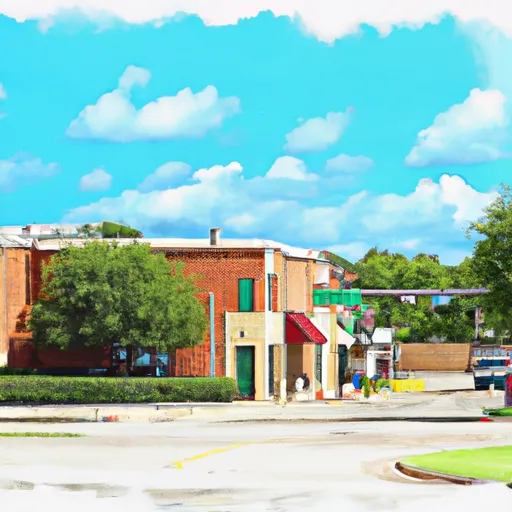-
 Snoflo Premium
Snoflo Premium
Get unlimited access to all our content
With no Ad interruptions! - Start Your Free Trial Login with existing account
Mirando-City
Eden Index
Climate
6.8
•
Recreation
•
Community
0.8
•
Safeguard
2.9/10

Mirando City is a small town located in Webb County, Texas. It experiences a semi-arid climate characterized by hot summers and mild winters. Average temperatures range from the mid-90s°F (mid-30s°C) in summer to the mid-60s°F (around 18°C) in winter. The region receives relatively low precipitation, with an average annual rainfall of around 20 inches. Summers are typically dry, while occasional thunderstorms occur in spring and fall.
Hydrologically, the area is influenced by the Rio Grande River, which is located approximately 15 miles to the west. Groundwater is the primary water source for the community, supplied by the underlying Carrizo-Wilcox Aquifer. Water conservation and management are important priorities for Mirando City due to the region's arid conditions.
Outdoor recreation opportunities in and around Mirando City include fishing, hunting, and hiking. The nearby Falcon Lake, a reservoir on the Rio Grande, offers excellent fishing opportunities for largemouth bass, catfish, and other species. The surrounding countryside provides ample opportunities for hunting game like deer, javelina, and wild turkey. Additionally, nature enthusiasts can explore the beautiful landscapes and trails in nearby state parks, such as Falcon State Park and San Ygnacio Historic District.
What is the Eden Index?
The Snoflo Eden Index serves as a comprehensive rating system for regions, evaluating their desirability through a holistic assessment of climate health, outdoor recreation opportunities, and natural disaster risk, acknowledging the profound impact of these factors on livability and well-being.
Climate Health Indicator (CHI): 6.8
Mirando-City receives approximately
561mm of rain per year,
with humidity levels near 90%
and air temperatures averaging around
22°C.
Mirando-City has a plant hardyness factor of
9, meaning
plants and agriculture in this region tend to thrive here all year round.
By considering the ideal temperature range, reliable water supplies, clean air, and stable seasonal rain or snowpacks, the Climate Health Indicator (CHI) underscores the significance of a healthy climate as the foundation for quality living.
A healthy climate is paramount for ensuring a high quality of life and livability in a region, fostering both physical well-being and environmental harmony. This can be characterized by ideal temperatures, reliable access to water supplies, clean air, and consistent seasonal rain or snowpacks.
Weather Forecast
Streamflow Conditions
Rio Grande-Falcon
Area Rivers
Rio Grande-Falcon
Snowpack Depths
Rio Grande-Falcon
Reservoir Storage Capacity
Rio Grande-Falcon
Groundwater Levels
Recreational Opportunity Index (ROI):
The Recreational Opportunity Index (ROI) recognizes the value of outdoor recreational options, such as parks, hiking trails, camping sites, and fishing spots, while acknowledging that climate plays a pivotal role in ensuring the comfort and consistency of these experiences.
Access to outdoor recreational opportunities, encompassing activities such as parks, hiking, camping, and fishing, is crucial for overall well-being, and the climate plays a pivotal role in enabling and enhancing these experiences, ensuring that individuals can engage in nature-based activities comfortably and consistently.
Camping Areas
| Campground | Campsites | Reservations | Toilets | Showers | Elevation |
|---|---|---|---|---|---|
| Falcon State Park | 122 | 345 ft | |||
| Falcon County Park | 50 | 353 ft |
Nearby Ski Areas
Catastrophe Safeguard Index (CSI):
The Catastrophe Safeguard Index (CSI) recognizes that natural disaster risk, encompassing floods, fires, hurricanes, and tornadoes, can drastically affect safety and the overall appeal of an area.
The level of natural disaster risk in a region significantly affects safety and the overall livability, with climate change amplifying these risks by potentially increasing the frequency and intensity of events like floods, fires, hurricanes, and tornadoes, thereby posing substantial challenges to community resilience and well-being.
Community Resilience Indicator (CRI): 0.8
The Community Resilience Indicator (CRI) recognizes that education, healthcare, and socioeconomics are crucial to the well-being of a region. The CRI acknowledges the profound impact of these elements on residents' overall quality of life. By evaluating educational resources, healthcare accessibility, and economic inclusivity, the index captures the essential aspects that contribute to a thriving community, fostering resident satisfaction, equity, and social cohesion.

